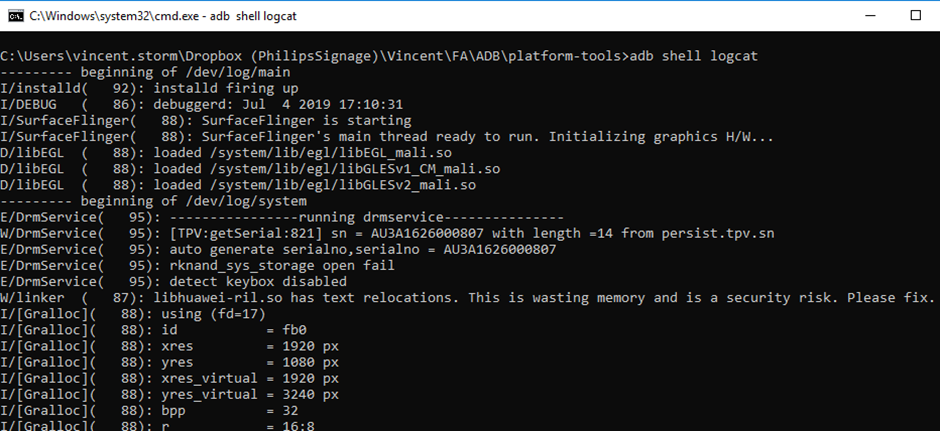BDL - Android Base Screen - Logging
The log file from an android based BDL models can be downloaded via the remote control or via ADB.
1. Via the remote control:
Insert an USB stick in the monitor, press “home 1666 back” in a sequence on the remote control > the log file will be copied to the USB stick.
After +/- 30 secs a message will be displayed on the monitor.
The log file will be copied to the internal memory if there is no USB inserted in the monitor.
How to get the log from the internal memory,
via FTP: ip address of the monitor, user: smartcms, pw: smartcms, port 2121
In the folder “/storage/emulated/0/bugreports” you will find the bugreport file.
2. Via ADB
The adb log files can be downloaded via USB (see pt2.2) or via the network ( see pt 2.3).
2.1 Download the adb tooling.
Download the ADB log tool here or from the android developer site.
Unzip and only copy the files to a folder on your PC.
No installation needed.
Run the command prompt (windows R, type cmd)
This will open the command window on your PC.
Use the cd (change dir) instruction to go to your file path.
“cd\ your path”
Your path is the location of your previously copied ADB files,
same file path as the “adb.exe”.
See below example, files are copied to “C:\Users\vincent.storm\Dropbox (PhilipsSignage)\Vincent\FA\ADB\platform-tools”
Use the cd (change dir) instruction to go to your path.
2.2 Get the log file via USB from the monitor
Connect an USB cable from your PC to the monitor OTG input (micro USB connector).
Note: it’s not supported via USB if there is no OTG input, but it’s working via the network, see the next chapter.
Open windows explorer, you should see the monitor model name:
type: adb devices (in the cmd window)
Your device (monitor) will be listed (see green marker below).
Save the logging from the monitor to a file, type:
adb logcat -v threadtime -d > logcat_log.txt
The logcat_log.txt will be saved in the same folder of the adb.exe path.
type: adb shell logcat > will display loggings in the command window, see pict below. 
2.3 Get the log files from the monitor via the network
The log files can also be copied from the monitor via the network.
Set ADB network active in the admin menu of your monitor.
Your PC and the monitor must be in the same network
Find the IP of your monitor.
Type the command: adb connect device_ip_address
Example: adb connect 192.168.0.198:5555
adb connect 192.168.0.198:5555
Could be that you get a message on the monitor to accept the connection. Once connected, type the command: adb devices
> your device will be listed:
$ adb devices
List of devices attached
device_ip_address:5555 device
Now type below to get the loggings
adb -s {monitor IP address}:5555 logcat -v threadtime > C:\temp\log.txt
example:
adb -s 192.168.0.208:5555 logcat -v threadtime > C:\tmp\log.txt
This will copy the loggings to your PC > C:\temp\log.txt
adb -s 192.168.0.198:5555 logcat > this will show the logging in the cmd window.
Kernel log file:
$ adb shell dmesg > kernel.txt
Trouble shooting:
The log files will be deleted from the monitor after an AC reboot.
To use adb, you must enable USB debugging in the device system settings, under Developer options, also if you do it over the network.
The Developer options can be found in the admin menu (home 1888 or for the tablets rounded button followed by the volume -)
USB must also be enabled in the admin menu of your monitor, also if you do it over the network.
ADB via network must be enabled in the admin menu if you use ADB via the network.
If the monitor is still not listed in windows explorer, install the RK_ADBDriver:
More info can be found on the develop android website:
Related Articles
BDL Android versions
What are the android versions on BDL? xxBDL3050Q Android 5.0.1 xxBDL3052T Android 5.0.1 xxBDL4050D Android 4.4.4 65BDL3051T Android 4.4.4 xxBDL4051T Android 4.4.4 xxBDL4150D Android 7.1 xxBDL3550Q Android 8.0.0 xxBDL4550D Android 8.0.0 Can I upgrade ...BDL - Dragon 1.5 (xxBDL5055P xxBDL5057P) - Android Module Software Update
PHILIPS P Line Android Module Software Update Download the latest android firmware: https://westanonline.sharepoint.com/:f:/s/Support/En4_bUolLahbj4BRjTvfbVwB5BGH-xKnlqVwAUyb0ZoGlg?e=3NmvCP In the root directory of a USB disk place ...Philips BDL Remote Control Not Working
Philips Signage Remote control not working: [1] Are you using the correct remote control (RC)? Part number: 398GRABDDNEPHT, see picture below: See important note at the end of this document [2] The green led must blink when you press the OK button on ...BDL - Dragon 1.0 (xxBDL4050D) - Android Module Software Update
PHILIPS D Line Android Module Software Update Check if the screen is already running the latest Software version (FB11.04). Press in sequence "info, 7, 7", check if the Android FW Version is FB11.04 Download the latest Android firmware: ...BDL (with built in Android) Setting up Media Player
Prepare files into a USB Drive Philips' Android based Media Player will look for content to be displayed in specific directories. Please put the contents according to their types into the following directories in the USB Drive: philips/video/ -> ...